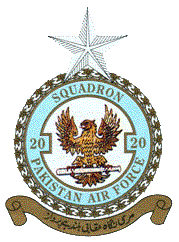No. 20 Squadron PAF
| No. 20 Squadron | |
|---|---|
 Logo of the squadron | |
| Active | Since March 1956 (68 years, 10 months and 19 days) |
| Disbanded | 1972-1977 |
| Country | |
| Allegiance | |
| Branch | |
| Type | Squadron |
| Role | Air Superiority |
| Part of | Central Air Command |
| Airbase | PAF Base MM Alam |
| Nickname(s) | Cheetahs |
| Motto(s) | مری نگاہ عقابی بلند ہے پرواز (Urdu for 'My aim is to fly high like the eagle') |
| Mascot(s) | Cheetah |
| Aircraft | Chengdu F-7PG |
| Engagements | |
| Commanders | |
| Notable commanders | Zulfiqar Ali Khan Sohail Aman |
| Aircraft flown | |
| Fighter | Shenyang F-6 Chengdu F-7P Chengdu F-7PG |
| Reconnaissance | Lockheed RT-33 Dassault Mirage-IIIRP |
| Trainer | Chengdu FT-7P |
No. 20 Air Superiority Squadron nicknamed Cheetahs is a unit of the Pakistan Air Force established in 1956. It flies the Chengdu F-7PG Airguard jets and is based at PAF Base MM Alam.[1][2][3][4] Initially formed as a photo reconnaissance flight at PAF Base Mauripur, the squadron has evolved over the decades, participating in significant missions and conflicts. It currently operates Chengdu F-7PG Airguard jets and is based at PAF Base MM Alam. The squadron has a rich history, including contributions to the demarcation of the China–Pakistan border, the World Bank's Indus Basin Project, and active roles in the 1965 and 1971 Indo-Pakistani wars. After being disbanded in 1972 and reactivated in 1977, the squadron transitioned through various aircraft, including the Dassault Mirage IIIRP and Shenyang F-6, before adopting the Chengdu F-7P Skybolts and later the F-7PGs. The squadron celebrated its Golden Jubilee in 2008 and continues to play a vital role in PAF's operational activities and exercises.
History

The unit was originally established in March 1956 as a photo reconnaissance flight at PAF Base Mauripur flying Lockheed RT-33 Shooting Stars under the command of Flight Lieutenant Zulfiqar Ali Khan. By 1957, the unit's status was upgraded to a squadron with the role of photo-recce. Over the next few years, the unit took part in several photographic survey missions over Northern Pakistan notably over the then disputed Trans-Karakoram Tract. In 1963, the RT-33s contributed to the demarcation of the China–Pakistan border by providing detailed photographic data.[3]
In 1964, the squadron's RT-33s facilitated the world bank's Indus Basin Project photographing major river basins of the Indus river. The unit also holds a key role in the selection of the site for the Mangla Dam and Tarbela dam.[3]
On the outbreak of the 1965 Indo-Pakistani war, the squadron flew 24 Aerial reconnaissance missions with the Lockheed RT-33s providing vital photographic data coverage to the PAF and the Army.[3]
During the 1971 Indo-Pakistani war, the squadron while based at PAF Base Rafiqui flew aerial recce missions over various battlefields in the western front. A detachment of the squadron was also sent to the Eastern Front at PAF Base Tejgaon which went on to support the Army's counter insurgency operation against Indian sponsored militants. However, it capitulated after the fall of dhaka and its RT-33 captured.[5]
After the war, the squadron was disbanded in June 1972 with its assets transferred to No. 2 Squadron. Upon its re-activation in June 1977, the squadron was re-equipped with Dassault Mirage-IIIRP photo-recce variants and assigned the role of day & night tactical attack and Reconnaissance.[3]
By May 1986, the unit was re-established as the No. 20 Air Superiority squadron with Shenyang F-6 fighters under the command of Wing Commander Shahid. Two years later, the squadron became the PAF's first unit to receive Chengdu F-7P Skybolts which replaced its vintage F-6s. It continued operating the Skybolts till 2002 when the improved Chengdu F-7PGs entered the squadron. In 2005, the squadron also undertook the responsibility of carrying out Operational Conversion Courses on the F-7PG whenever required.[3]

The squadron celebrated its Golden jubilee in January 2008. Four years later, the squadron shifted to PAF Base MM Alam after spending 36 years at PAF Base Rafiqui where it remains to this day.[4]

Exercises
Over the years, the No. 20 AS Squadron has took part in all operational activities and PAF Exercises.[4]

- Dissimilar Air Combat Training (DACT) camps
- Surface Attack Camps
- Inter Squadron Armament Competition (ISAC)
- Exercise High Mark
- Exercise Hawk Eye
- Exercise ATLC
- Exercise Shaheen II
See also
References
- ^ "PAF Squadrons". PAF Falcons. Archived from the original on 2014-07-18.
- ^ "20 Squadron PAF". GlobalSecurity.org.
- ^ a b c d e f Warnes, Alan. The Pakistan Air Force (1998-2008): A New Dawn. Key Publishing. p. 165.
- ^ a b c Hashmi, Qadeer (2014). History of the Pakistan Air Force 1999-2013 (1st ed.). p. 299.
- ^ Tufail, Kaiser (2020). Against All Odds: The Pakistan Air Force in the 1971 Indo-Pakistan War. Helion & Company. ISBN 978-1913118648.
